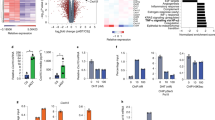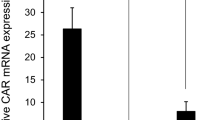Abstract
Purpose
Among diverse Pattern Recognition Receptors (PRRs), Toll-like receptor-4 (TLR-4) is a key urothelial trigger for innate immune response impacting urothelial bladder carcinoma (BC). Androgen activation promotes immunotolerance, playing an immunoregulatory role by unknown mechanisms. We explored the castration impact on urothelial TLR-4 modulation in carcinogenesis and immunotherapeutic scenario.
Methods
Intact (SHAM) versus castrated male Fisher-344 rats were evaluated in 2 scenarios: (A) Carcinogenesis: After randomization to SHAM (n = 5) and Castration (n = 5), carcinogenesis was induced by four intravesical doses of 1.5 mg/kg n-methyl-n-nitrosourea (MNU) every 15 days. (B) Treatment: After ultrasonographic confirmed MNU-induced papillary BC on week 8, rats were randomized to SHAM (n = 5) and Castration (n = 5) and offered 6 weekly intravesical treatment of 106 CFU of bacillus Calmette Guerin (BCG) in 0.2 ml saline. After 15 weeks the urinary bladders underwent histopathology. Urothelial cell proliferation was measured by Ki-67 immunohistochemistry (IHC), and TLR-4 expression was quantified by IHC and WB.
Results
Castration induced higher TLR-4 urothelial expression (p = 0.007) and anticarcinogenic effect with fewer urothelial tumors (60 vs. 80%) and lower urothelial cell proliferation compared to intact animals (p = 0.008). In the intravesical BCG treatment setting, castration has potentialized the BCG activation of TLR-4 (p = 0.007) with no residual in situ carcinoma compared to intact animals, suggesting the potential to amplify the BCG immune response.
Conclusion
To our knowledge, this is the first description of TLR-4 urothelial expression hormonal modulation. The described castration-mediated immunomodulation will help to improve the knowledge of urothelial cancer gender diversities and PRRs modulations with treatment implications.




Similar content being viewed by others
References
Burge F, Kockelbergh R (2016) Closing the gender gap: can we improve bladder cancer survival in women? a systematic review of diagnosis, treatment, and outcomes. Urol Int 97:373–379
Elzamy S, Ms AA, Kandeel W (2018) The prognostic significance of androgen receptor and beta-catenin immunohistochemical expression in urothelial carcinoma with and without detrusor muscle invasion from an Egyptian institution. Pol J Pathol 69:234–242
Askeland EJ, Newton MR, O’Donnell MA, Luo Y (2012) Bladder cancer immunotherapy: BCG and beyond. Adv Urol 2012:1–13
Bevers RF, Kurth KH, Schamhart DH (2004) Role of urothelial cells in BCG immunotherapy for superficial bladder cancer. Br J Cancer 91(4):607–612
Weinstein Y, Ran S, Segal S (1984) Sex-associated differences in the regulation of immune responses controlled by the MHC of the mouse. J Immunol 132:656–661
Zuk M (2009) The sicker sex. PLoS Pathog 5(1):1000267
Williams KM, Lucas PJ, Bare CV, Wang J, Chu YW, Tayler E, Kapoor V, Gress RE (2008) CCL25 increases thymopoiesis after androgen withdrawal. Blood 112(8):3255–3263
Geller SE, Koch AR, Roesch P, Filut A, Hallgren E, Carnes M (2018) The more things change, the more they stay the same: a study to evaluate compliance with inclusion and assessment of women and minorities in randomized controlled trials. Acad Med 93:630–635
Imada S, Akaza H, Ami Y, Koiso K, Ideyama Y, Takenaka T (1997) Promoting effects and mechanisms of action of androgen in bladder carcinogenesis in male rats. Eur Urol 31(3):360–364
Mizushima T, Jiang G, Kawahara T, Li P, Han B, Inoue S, Kato HII, Jalalizadeh M, Miyagi E, Fukuda M, Reis LO, Miyamoto H (2020) Androgen receptor signaling reduces the efficacy of bacillus calmette-guérin therapy for bladder cancer via modulating rab27b-induced exocytosis. Mol Cancer Ther 19(9):1930–1942
Kashiwagi E, Ide H, Inoue S, Kawahara T, Zheng Y, Reis LO, Baras AS, Miyamoto H (2016) Androgen receptor activity modulates responses to cisplatin treatment in bladder cancer. Oncotarget 7(31):49169–49179
Salustiano ACC, Riccetto E, Kiehl IG, Ossick MV, Ferrari KL, Denardi F, Reis LO (2021) Autochthonous male urothelial carcinoma immune competent model: from induction to BCG transurethral treatment. Int J Clin Exp Pathol 14(9):980–986
Reis LO, Ferreira U, Billis A, Cagnon VH, Fávaro WJ (2012) Anti-angiogenic effects of the superantigen staphylococcal enterotoxin B and bacillus Calmette-Guérin immunotherapy for nonmuscle invasive bladder cancer. J Urol 187(2):438–445
Montironi R, Lopez-Beltran A (2005) The 2004 WHO classification of bladder tumors: a summary and commentary. Int J Surg Pathol 13(2):143–153
Reis LO, Sopena JM, Fávaro WJ, Martin MC, Simão AF, Reis RB, Andrade MF, Domenech JD, Cardo CC (2011) Anatomical features of the urethra and urinary bladder catheterization in female mice and rats. an essential translational tool. Acta Cir Bras 2:106–110
Yang Y, Huang CT, Huang X (2004) Pardoll DM (2004) Persistent Toll-like receptor signals are required for reversal of regulatory T cell-mediated CD8 tolerance. Nat Immunol 5:508–515
Wculek SK, Cueto FJ, Mujal AM, Melero I, Krummel MF, Sancho D (2020) Dendritic cells in cancer immunology and immunotherapy. Nat Rev Immunol 20:7–24
Vidyarthi A, Khan N, Agnihotri T, Negi S, Das DK, Aqdas M, Chatterjee D, Colegio OR, Tewari MK, Agrewala JN (2018) TLR-3 stimulation skews M2 macrophages to M1 through IFN-alphabeta signaling and restricts tumor progression. Front Immunol 9:1650
Camargo JA, Passos GR, Ferrari KL, Billis A, Saad MJA, Reis LO (2018) Intravesical immunomodulatory imiquimod enhances bacillus calmette-guérin downregulation of nonmuscle-invasive bladder cancer. Clin Genitourin Cancer 16(3):e587–e593
Zhang Y, Huo F, Cao Q, Jia R, Huang Q, Wang ZA, Theodorescu D, Lv Q, Li P, Yan C (2022) FimH confers mannose-targeting ability to Bacillus Calmette-Guerin for improved immunotherapy in bladder cancer. J Immunother Cancer 10(3):e003939
Flanagan KL, Fink AL, Plebanski M, Klein SL (2017) Sex and gender differences in the outcomes of vaccination over the life course. Annu Rev Cell Dev Biol 33:577–599
Furman D, Hejblum BP, Simon N, Jojic V, Dekker CL, Thiebaut R, Tibshirani RJ, Davis MM (2014) Systems analysis of sex differences reveals an immunosuppressive role for testosterone in the response to influenza vaccination. Proc Natl Acad Sci USA 111(2):869–874
Olbert PJ, Kesch C, Henrici M, Subtil FS, Honacker A, Hegele A, Hofmann R, Hänze J (2015) TLR4- and TLR9-dependent effects on cytokines, cell viability, and invasion in human bladder cancer cells. Urol Oncol 33(3):110.e19–27
Quintar AA, Roth FD, De Paul AL, Aoki A, Maldonado CA (2006) Toll-like receptor 4 in rat prostate: modulation by testosterone and acute bacterial infection in epithelial and stromal cells. Biol Reprod 75(5):664–672
Rettew JA, Huet-Hudson YM, Marriott I (2008) Testosterone reduces macrophage expression in the mouse of toll-like receptor 4, a trigger for inflammation and innate immunity. Biol Reprod 78(3):432–437
Kusuhara Y, Daizumoto K, Kawai K, Hirayama K, Kowada M, Shintani T, Fukuhara Y, Dondoo T-O, Ozaki K, Tsuda M, Fukawa T, Nakatsuji H, Bando Y, Uehara H, Fukumori T, Takahashi M, Kanayama HO (2019) Low expression of toll-like receptor 4 is associated with poor prognosis in bladder cancer. Anticancer Res 39(2):703–711
Reis LO, Ferrari K, Zamuner M, Rocha GZ, Billis A, Fávaro WJ (2015) Urothelial carcinogen resistance driven by stronger Toll-like receptor 2 (TLR2) and Uroplakin III (UP III) defense mechanisms: a new model. World J Urol 33(3):413–419
Desmet CJ, Ishii KJ (2012) Nucleic acid sensing at the interface between innate and adaptive immunity in vaccination. Nat Rev Immunol 12(7):479–491
Sato-Kaneko F, Yao S, Ahmadi A, Zhang SS, Hosoya T, Kaneda MM, Varner JA, Pu M, Messer KS, Guiducci C, Coffman RL, Kitaura K, Matsutani T, Suzuki R, Carson DA, Hayashi T, Cohen EE (2017) Combination immunotherapy with TLR agonists and checkpoint inhibitors suppresses head and neck cancer. JCI Insight 2(18):e93397
Wang S, Campos J, Gallotta M, Gong M, Crain C, Naik E, Coffman RL, Guiducci C (2016) Intratumoral injection of a CpG oligonucleotide reverts resistance to PD-1 blockade by expanding multifunctional CD8+ T cells. Proc Natl Acad Sci USA 113(46):E7240–E7249
Ayari C, Bergeron A, LaRue H, Ménard C, Fradet Y (2011) Toll-like receptors in normal and malignant human bladders. J Urol 185(5):1915–1921
Arnegard ME, Whitten LA, Hunter C, Clayton JA (2020) Sex as a biological variable: a 5-year progress report and call to action. J Womens Health (Larchmt) 29(6):858–864
Acknowledgements
We would like to thank the expert uropathologist, Prof. Athanase Billis for the urothelial tumors’ classification.
Funding
Ministério da Ciência e Tecnologia/Conselho Nacional de Desenvolvimento Científico e Tecnológico—CNPq, processo 304747/2018–1.
Author information
Authors and Affiliations
Contributions
RLO: Protocol/project development, Data analysis, Manuscript writing/editing. Salustiano ACC and Kiehl IGA: Data collection/management/analysis. Capibaribe DM, Denardi F: Data analysis.
Corresponding author
Ethics declarations
Conflicts of interest
None.
Research involving human participants and/or animals
Local Animal Research Ethics Committee Approval no 4541–1/2017 (CEUA/UNICAMP).
Informed consent
Not applicable.
Additional information
Publisher's Note
Springer Nature remains neutral with regard to jurisdictional claims in published maps and institutional affiliations.
Supplementary Information
Below is the link to the electronic supplementary material.
11255_2022_3336_MOESM1_ESM.tiff
Supplementary Fig. 1: Study design: groups, interventions, and weeks of protocol (b: bladder, p: prostate) (TIFF 2377 KB)
11255_2022_3336_MOESM2_ESM.pdf
Supplementary Fig. 2: Representative bladder urothelial cancer pTa, pT1 low-grade and pT1 high-grade in the male counterpart of Fisher 344 immunocompetent bladder cancer model (PDF 3576 KB)
11255_2022_3336_MOESM3_ESM.tiff
Supplementary Fig. 3. Protein quantification of TLR-4 in the bladder, Western Blotting. Different letters denote p < 0.05 (TIFF 2377 KB)
Rights and permissions
Springer Nature or its licensor holds exclusive rights to this article under a publishing agreement with the author(s) or other rightsholder(s); author self-archiving of the accepted manuscript version of this article is solely governed by the terms of such publishing agreement and applicable law.
About this article
Cite this article
Reis, L.O., Salustiano, A.C.C., Capibaribe, D.M. et al. Castration immunoregulates toll-like receptor-4 in male bladder cancer. Int Urol Nephrol 54, 2845–2853 (2022). https://doi.org/10.1007/s11255-022-03336-9
Received:
Accepted:
Published:
Issue Date:
DOI: https://doi.org/10.1007/s11255-022-03336-9




